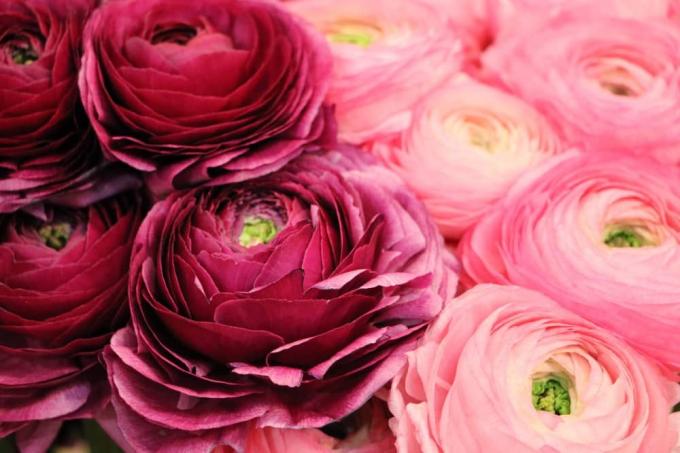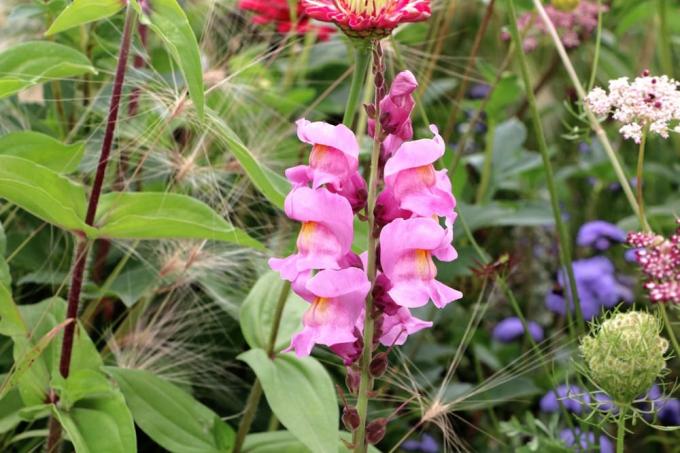

Table of contents
- hardiness
- tubers overwinter
- winter quarters
- aftercare
- Repot & implement
- multiply
When the ranunculus sheds its leaves after flowering, then the time has come to plan the overwintering of the sensitive plant. Since the perennial flowers are only partially hardy, they are dependent on additional protective measures in the winter months. Without this winter protection, the plants can freeze to death in severe and prolonged frost. As an alternative, the tubers can spend the winter in a frost-free place.
hardiness
The distinctive flowers come from Asia and are not used to the local temperature values with the low degrees of frost due to their origin. That is why ranunculus in free-range husbandry can only stay outside undamaged in winter if the location is not too cold and exposed. At extreme altitudes with sub-zero temperatures, the long-lasting frost would damage the plants. In extreme cases, the flowers and their tubers can even freeze to death. It is therefore generally safer to dig up the tubers and overwinter in a frost-free place.
- Are only badly hardy
- Overwintering is only possible without problems in mild regions
- This includes the German wine-growing regions and protected valleys
- Be sure to protect bulbous plants from frost
- Lay out a warm blanket of brushwood or compost
- In extremely cold regions, lay out additional garden fleece
tubers overwinter
Some of the ranunculus varieties are already somewhat used to the local winter due to local breeding and score points with better winter hardiness. However, if you don't want to take any risks, you should bring in the tubers. The right period of time and suitable preparation play an important role. When it comes to the time period, the weather forecast should be taken into account in order to accommodate the bulbous structures in good time. When the temperature levels reach a critical point, it's time to move the ranunculus bulbs. With suitable preparation for hibernation, the tubers can survive the winter months outside the soil without any problems.
- Critical temperature values are around 5°C during the day
- Ideally, take the tubers out of the ground around mid-October
- Stop fertilizing first
- Then remove all dead parts above ground
- Then dig out carefully
- Clean of any soil residue
- Carefully remove the bulbous tubers
- Allow tubers to dry sufficiently
- Wrap in plain paper or newspaper for extra protection
winter quarters

Especially when the ranunculus is cultivated in a planter on the balcony or terrace, it needs a suitable place to overwinter. But the plants in free-range husbandry also benefit from a move to an adequate winter quarters. For this, the ranunculus bulbs must be removed from the ground and stored in a place protected from frost. There the tubers are put into a winter dormant mode. These no longer sprout, but are in a resting phase. The following spring, the root bulbs are brought back to life.
- Unheated basements, garages or attics are ideal
- Rooms must be cool but completely frost-free
- Also dark, airy and dry
- Optimum temperature values are between 5-8° C
aftercare
After hibernation, the tubers need special aftercare so that they can settle again in the ground or planter without any problems. In this way, the ranunculus is very carefully brought back to life. However, no more hard frosts should be expected, only then can the tubers move back outside. This point in time is significantly later in higher mountain areas than in protected regions with a mild climate.
- Hibernation should last until March or April
- Check tubers for any damage
- Place in a bowl of cool water for about 5 hours
- Then dig 3-4 cm deep into the ground
- Only fertilize when the first leaves can be seen
Repot & implement
If the ranunculus stays in the same place for many years, then it's time to implement it. In this way, the soil can recover and replenish the nutrients that have been consumed up to that point. Since the tubers are brought into the house in autumn anyway, the move can be carried out in this context. If the location is still relatively new, then the tubers can be planted again in the spring in the same places. This should also be done when keeping pots and tubs, as the plant substrate will eventually be exhausted.
- Ideally transplant tubers every two to four years
- Choose a new location with nutrient-rich soil
- Cool and moist soil is important
- Tolerates both partially shaded and sunny light conditions
- Proceed similarly with ranunculus in flower pots and tubs
- Change plant substrate every few years
- Always pay attention to permeable substrate
- If there are numerous bulbs, moving to larger pots is necessary
multiply

The ranunculus reproduces on its own, so this process is very easy to carry out. The propagation can also be carried out in the course of the winter, since the distinctive flowering plants normally form brood bulbs over the course of the year. These form themselves as offshoots on the mother tubers of the ranunculus. For propagation, the bulbous bulbs only need to be detached when the onions are moved. This type of propagation is possible all year round as soon as new bulbs appear.
- A small and very sharp knife is ideal for cutting
- Apply pressure carefully and slightly
- Mother and brood tubers must not be damaged
- Prefer indoors in winter
- Direct planting outdoors is possible at the beginning of spring
 garden editorial
garden editorial I write about everything that interests me in my garden.
Learn more about plant overwintering

Is the triplet flower hardy? 10 tips for wintering
The enchanting bougainvillea got its botanical name after its discoverer, the navigator Louis de Bougainville. On the Mediterranean Sea, it embellishes house facades. In Germany, where it is also known as a triplet, it is particularly popular as a container plant. How is it overwintered?

Overwintering poinsettia | Is he hardy?
The poinsettia belongs to the winter season like no other plant. But is it also a plant that is hardy or does it have special requirements when it comes to overwintering? The answers can be found at Hausgarten.net.

Is the snapdragon hardy? | 7 tips for overwintering snapdragons
The snapdragon is considered a classic among the ornamental flowers of the domestic plant bed. It blooms happily and handsomely over many Mondays. But is the snapdragon also hardy and how does the perennial overwinter? You will find the answer to these questions with us.

Night jasmine, Cestrum nocturnum - care and wintering
The night jasmine has developed into a popular container plant in this country. One reason for this is certainly its beautiful trumpet flowers, which unfold like a star. In order for this to work, however, it depends on the right location and care. More about this is here.

Is the Japanese maple hardy? This is how you overwinter it properly
The Japanese maple is so popular in the local latitudes because it can be cultivated in the garden and in a bucket. Because the tree has its origin in the Japanese mountain regions, where there is a similar climate. It is therefore not difficult to get the plant through the winter well.

Overwintering lemon verbena from A-Z | Is Lemon Shrub Hardy?
One of the most refreshing scents in the home herb garden comes from lemon verbena. Growing them is worth it for that alone. Whether in a bed or in a bucket, it thrives everywhere in summer. Only the cold winter reveals its distant origin. What now?



